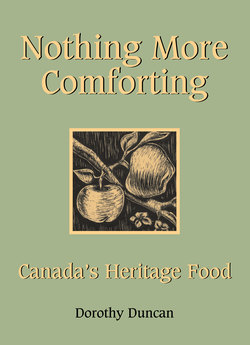Читать книгу Nothing More Comforting - Dorothy Duncan - Страница 12
На сайте Литреса книга снята с продажи.
Is There a Devil in the Dairy?
ОглавлениеLittle Miss Muffet Sat on a tuffet, Eating her curds and whey; There came a big spider, Who sat down beside her, And frightened Miss Muffet away.
Sixteenth-century rhyme
About ten thousand years ago, when the first animals were domesticated, milk, butter, and cheese became an important part of our ancestors’ diet. The white liquid, which in Old English was called milc, came from the mammary glands of cows, goats, and sheep, and it has been consumed at one time or another by most of the world’s people.
Attitudes to drinking milk have changed dramatically over the centuries, and they have also depended on our station in life. In the Middle Ages, for example, the wealthy believed that milk was intended only for the elderly, invalids, and children, while the peasants all tried to keep at least one cow, which furnished their daily food — curds and whey, buttermilk, butter, and cheese.
We read about butter in the Holy Bible, usually with references to honey, indicating how special this food was to the ancients. It is believed that, like yogurt, butter was discovered accidentally by wandering herdsmen carrying milk in goatskin vessels on their camels.The jolting of the beasts acted as a sort of churn, agitating the milk, and either butter or yogurt was formed. Butter was well established as an important food in Europe and Great Britain by the Middle Ages; by the twelfth century the Germans were exporting butter to Norway, and butter made in Normandy was being sold in Paris by the fourteenth century.
Many types of vessels were used as churns, but it was not until about 1600 that a wooden churn was developed in Normandy. It appeared soon afterward in Switzerland, and it was to be the prototype for the churns that our ancestors knew so well.These churns survive today in many museum collections and in many homes as a nostalgic reminder of the past.
Despite its popularity in the Old World, milk was not known in the New World until the Spanish and the English brought milk animals. The First Nations in the Americas would have been introduced to this magic liquid by the newcomers to their shores. For the early settlers in Canada, milk was a traditional part of their diet, well known as a beverage, and an important ingredient in cooking and baking. Every settler wanted to keep at least one cow to provide a steady supply of milk and cream for use on the table, in recipes, and in creating butter and cheese. The pioneering years demanded that every housewife carefully husband her resources. Mrs. Child in The Frugal Housewife, published in 1832, dedicated her work to “those who are not afraid of economy.” She not only taught her readers how to clean and restore their textiles and fabrics with skim milk, but also how to restore food with it:
As far as it is possible, have bits of bread eaten up before they become hard. Spread those that are not eaten, and let them dry, to be pounded for puddings, or soaked for brewis. Brewis is made of crusts and dry pieces of bread, soaked a good while in hot milk, mashed up, and salted, and buttered like toast.
The temperance movement also promoted milk, as it was considered, like water, to be an appropriate beverage to be enjoyed by those who had given up the demon alcohol.The well-being and success of many Canadian farmers depended on the health of their cattle and a good yield of milk. Despite their best efforts, they often had cows go dry, sour milk, rancid butter, or bad cheese. They could not believe that these misfortunes befell them because of unhygienic conditions in their barns and dairies, and often attributed these mishaps to witches, fairies, the evil eye, or the Devil himself.
